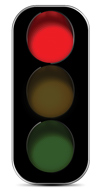|
||
RED LIGHT CAMERAS MAKE INTERSECTIONS SAFER
The number of U.S. communities using red light cameras has grown to about 540 as study after study shows that the devices improve safety. A 2011 IIHS study of large cities with long standing red light cameras found that cameras reduced the fatal red light running crash rate by 24 percent and the rate of all types of fatal crashes at signalized intersections by 17 percent. In Arlington, cameras were installed at four heavily traveled intersections in June 2010. Each intersection got one camera covering a single approach. Following a 30 day warning period, the county began issuing citations carrying $50 fines for violations caught on camera. A press release was issued when the cameras were turned on and then another when ticketing began. Signs were installed at the camera enforced approaches, but nowhere else. In contrast, some jurisdictions place signs at their borders or on streets throughout the community. To calculate how the cameras affected violation rates researchers at the Institute, which is located in Arlington, videotaped traffic during the warning period, a month after ticketing began and again after a year. In addition to the four camera enforced intersections, videotaping was done at four other intersections in Arlington, two on the same corridors where cameras were located and two elsewhere, to see if there was any spillover effect from the cameras. Four control intersections in neighboring Fairfax County, which does not have a camera program, also were observed. One year after the start of ticketing the odds of a red light running violation at the camera locations went down. Violations occurring at least 0.5 seconds after the light turned red were 39 percent less likely than would have been expected without cameras. Violations occurring at least 1 second after were 48 percent less likely, and the odds of a violation occurring at least 1.5 seconds into the red phase fell 86 percent. Percent difference in odds of red light violations at intersections
"What these numbers show is that those violations most likely to lead to a crash are reduced the most," McCartt says. "The longer the light has been red when a violator enters an intersection, the more likely the driver is to encounter a vehicle traveling in another direction or a pedestrian." At the two noncamera sites on camera corridors, the odds of violations also were lower than would have been expected without the camera program. As with the camera intersections, the further into the red phrase, the bigger the effect. However, these results were smaller than at the camera intersections and not always statistically significant. At the two other noncamera sites in Arlington the odds of violations increased. The lack of a broad spillover effect isn't surprising given the modest scope of the program and accompanying publicity. "Given the small number of cameras and signs it's likely that many Arlington drivers didn't even know about the enforcement while those who were aware probably knew the cameras were limited to a few locations," McCartt says. That could soon change. The county's fiscal 2013 budget contains funds for additional cameras. "We would expect a broader effect to emerge after the program's expansion into other parts of Arlington," McCartt notes.
© 2013 TLC Magazine Online, Inc. |

